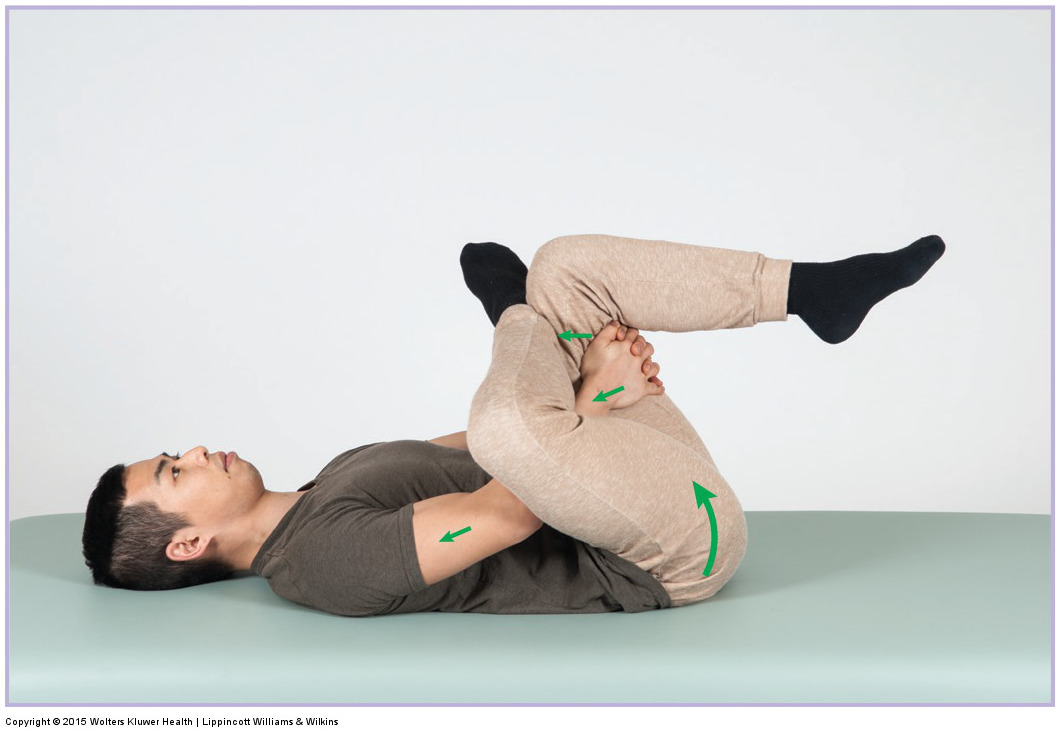Self-care for the client/patient:

Self-care “Figure 4” stretch for the piriformis. Permission: Joseph E. Muscolino. Manual Therapy for the Low Back and Pelvis – A Clinical Orthopedic Approach (2015).
Self-care for piriformis syndrome involves moist heat followed by stretching. The client/patient can perform either the Figure 4 or the horizontal adduction stretch. It is also important to avoid postures that would likely cause the piriformis to become tight. Postures that involve lateral rotation of the thigh at the hip joint would result in adaptive shortening and therefore tightening of the lateral rotators, including the piriformis. A typical example is sitting with the legs crossed with the ankle on the opposite-side thigh. If the client/patient overpronates, this should be corrected because it places an increased stress on the piriformis to prevent the leg and thigh from falling into medial rotation.
Self-care trigger point work can also be done by having the client roll on a ball (such as a soft ball or perhaps a commercially desgined ball by Yoga Tune Up® or other company).
Medical approach:
The medical community does not often recognize Piriformis syndrome. When it does, typical allopathic treatment includes oral steroidal anti-inflammatory (cortisone) medication, as well as cortisone injection into the gluteal region.
Manual therapy case study:
Raj is a marketing and sales manager for a large corporation who travels extensively by car for his work. He has noticed a tingling into his left foot. The tingling began insidiously approximately two weeks ago but has quickly worsened and is now quite uncomfortable. He notices that it tends to be worse during the week after long drives. He has decided to consult an orthopedic manual therapist to see if massage could help.
The therapist performed passive straight leg raise (SLR), slump test, cough test and Valsalva maneuver. Raj was negative for referral to slump test, cough and Valsalva, but SLR did slightly reproduce the tingling. Nachlas and Yeoman’s test were performed and resulted in mild left sacroiliac pain, but did not reproduce the tingling. Motion palpation of Raj’s sacroiliac joints demonstrated hypomobility on the left side. His low back ranges of motion are normal. His erector spinae musculature on the left side is moderately to markedly tight. His piriformis on the left side is markedly tight and tender to palpation, and reproduces a faint sensation of tingling into his left foot. His left thigh medial (internal) rotation range of motion is decreased and postural exam reveals that Raj stands with his left foot flared out laterally (his left thigh laterally rotated). Local examination of this left foot revealed no sign of pathology.
Given that Raj has been experiencing tingling in the left foot, which is typical of sciatica, it seemed fairly certain that he was experiencing sciatica. What the therapist had to determine was the cause or causes. Positive SLR indicates sciatic nerve compression. However, because the slump test, cough and Valsalva maneuver were negative, there is a good chance that the compression is not coming from the lumbar spine. Tightness of the left piriformis, with reproduction of the characteristic tingling indicates that piriformis syndrome is likely the cause of the sciatic compression. Left sacroiliac pain with Nachlas and Yeoman’s tests make it likely that the piriformis is tightening as a compensatory mechanism to stabilize an unhealthy sacroiliac joint.
The therapist recommended that Raj come in twice a week for three weeks to work on his piriformis and sacroiliac joint. Additionally, the therapist’s treatment plan included soft tissue manipulation and stretching to the lumbar extensor and hamstring musculature, especially on the left side. Given that there was still a chance that some or all of the nerve compression was coming from nerve impingement at the spine, the therapist was careful to pay attention to how Raj progressed with treatment (especially given that double knee to chest stretch which would be part of the treatment plan would possibly aggravate a disc pathology, if present).
The therapist’s session consisted of moist heat, soft tissue manipulation, pin and stretch, and horizontal adduction stretch to the left piriformis, as well as work to all of the lateral rotation musculature in the gluteal region. This was followed by moderate depth pressure to Raj’s low back and hamstrings bilaterally, and also knee to chest and double knee to chest stretches. The therapist then gently mobilized Raj’s sacroiliac joint. For self-care, the therapist recommended that Raj apply moist heat and stretch his piriformis, as well as his hamstrings, and his lumbar erector spinae with double knee to chest stretch. It was also recommended that Raj avoid sitting and driving as much as possible for the next few weeks, and that he begin Pilates to build up his core strength.
At the end of three weeks, Raj’s symptoms were relieved. The therapist progressively weaned Raj down to one visit every two to four weeks for proactive care.


